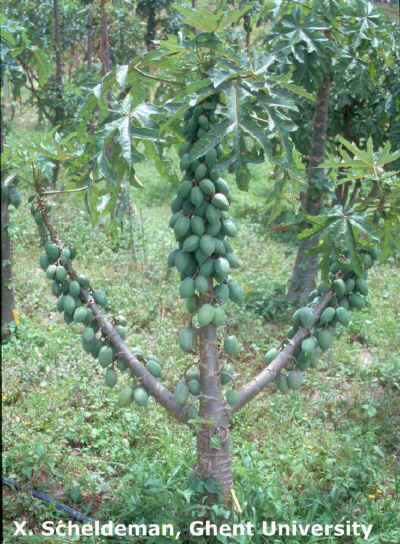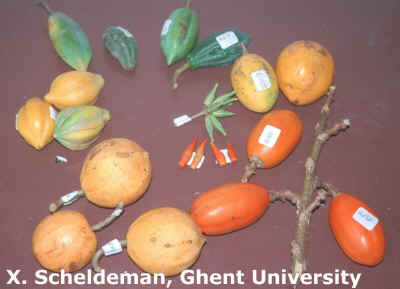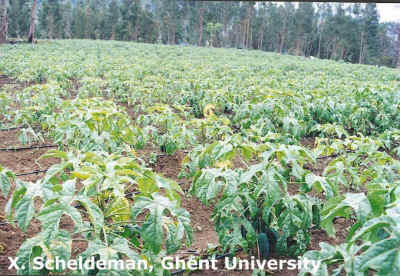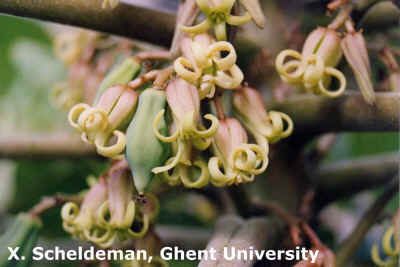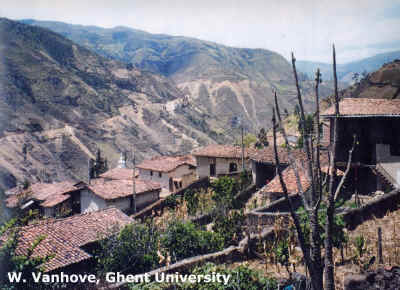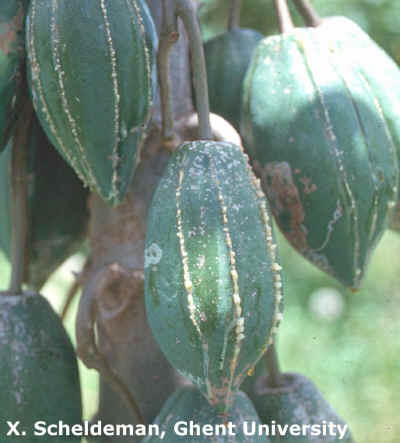General
Morphology
Apart from one climber species (V. horovitziana), Vasconcella species are all semi-lignose shrub to tree-like species with an erect habit. The stem is medullose (contrary to the hollow stem of the Carica genus), mostly unarmed (although stipules sometimes can be converted into spines (V. stipulata)). Leaves are generally entire or lobed although heart-shaped (V. candicans) and compound palm-shaped leaves (V. palandensis) can also be found. Plants are generally dioecious although monoeciousness can be present (e.g. V. monoica, V. cundinamarcensis), and then mostly with unisexual flowers. Male inflorescences are always multi-flowered and usually long-pedunculated and paniculate. Female inflorescences are single-flowered or pauciflorous with short peduncle. Flowers are typically 5-merous with a small calyx and tubular corolla. Male flowers show diplostemonous stamens with filaments free or fused above the corolla mouth. Female flowers show an incompletely 5-locular ovary with 5 entire or branched stigmata. Fruits are baccate with crested seeds often embedded in gelatine-like sarcotesta.
Taxonomy
Genus Vasconcella
has been recently (Badillo, 2000) rehabilitated as a proper genus instead of
being a section of genus Carica. Due to easy natural hybridisation
between species of the Vasconcella genus, proper species identification
can be difficult. This can be illustrated by the existence of the hybrid V.
×
heilbornii with its different
varieties, which have not all been described yet (Badillo, 1993). A taxonomical
revision using AFLP analysis, currently under way at Ghent University, could
shed another light on the taxonomical classification and the relation between
species. Recently, a newly discovered species, V. palandensis (Badillo et
al., 2000), was added to the genus Vasconcella putting the total number
of species within the genus at 21.
Economic
Importance
In comparison with papaya (C. papaya), Vasconcella species are clearly less important. Nevertheless and due to the big variability in environments where the different species can be found, Vasconcella species are consumed, raw or prepared, by many, especially indigenous people. Babaco (Vasconcella × heilbornii cv. ‘babacó’) is gaining more importance in Ecuadorian Andean fruit production, with a production of 632 metric tons in 1996 (Soria et al. 1999). Worldwide, babaco is being cultivated on a smaller scale in countries as New Zealand, Italy, Spain and South Africa. V. cundinamarcensis is being cultivated on a commercial scale in Chile where it is sold as ababai.
Reproductive
biology
Vasconcella species generally show unisexual flowers, mostly in
dioecious plants. Little studies about floral biology in Vasconcella have
been realized, but pollination between different flowers probably occurs by
insects. In the case of the natural hybrid Vasconcella
×
heilbornii fruit set occurs parthenocarpic, without the need for
pollen to initiate fruit set. Nevertheless, presence of pollen can induce
formation of a few viable seeds.
Propagation
and Cultivation Cycle
Vasconcella
species are generally propagated by seeds
although vegetative propagation by stem cuttings is possible in some species.
Germination can be slow (average 30 days) and difficult, but is always improved
by applying a pre-soaking of 24 h with gibberelic acid (GA3). In the
case of the natural hybrid Vasconcella
× heilbornii propagation
is easily realized by stem cuttings, although sometimes the few viable
(cross-pollinated) seeds may be germinated using GA3,
a valuable tool to widen variability. Interspecific grafting is also
possible, especially to avoid some root fungi and nematodes in susceptible
species.
Seedlings
(4-6 months) or rooted stem cuttings can be planted in the field, distances
varying by species. Sex determination can only be effectuated at first
flowering, so multiple planting (using 3 plants per pocket) with a selection at
first flowering is advised. Nevertheless, in dioecious species it is necessary
to maintain some male pollinators for adequate fruit set. In the case of the
parthenocarpic Vasconcella × heilbornii, its propagation
by cuttings results in homogeneous female fields. Flowering starts,
depending on the species, some months after transplanting and the first fruits
can be harvested 6 months later.
Distribution
Vasconcella
species can be found in wild in a broad
ecological range from dry coastal tropical lowlands (V. parviflora) over
the humid subtropical forests (V. weberbaueri) to temperate regions (V.
chilensis). Nevertheless, its centre of diversity is located in the Andean
highlands from Colombia to Peru with a hot spot in Southern Ecuador and Northern
Peru.
Potential
Direct
use of Vasconcella species consists of consumption of the fruits (rarely
leaves) that can be eaten raw or prepared into juices, preserves or candies
where addition of sugar results in enhanced aroma. Hybridisation of different
species (natural or artificial) or collection of wild rare Vasconcella ×
heilbornii varieties can even widen the big pomological and organoleptic
palette. Another important use of Vasconcella species is the extraction
of the proteolytic enzyme complex papain, used commonly in
food and pharmaceutical industry. Preliminary analyses (Scheldeman et al., 2000)
of some Vasconcella species show that the activity of the dried latex,
especially in V. stipulata, is up to 20 times higher than that of Carica
papaya cultivars selected for their high papain activity. Resistance
against some important diseases is present in a number of species. It can also
be used in papaya breeding or in babaco cultivation, a species very susceptible
to Fusarium fungi and Meloidogyne nematodes. Currently,
research on grafting of babaco on more resistant Vasconcella species like
V. weberbaueri, is carried out at INIAP in Ecuador.
